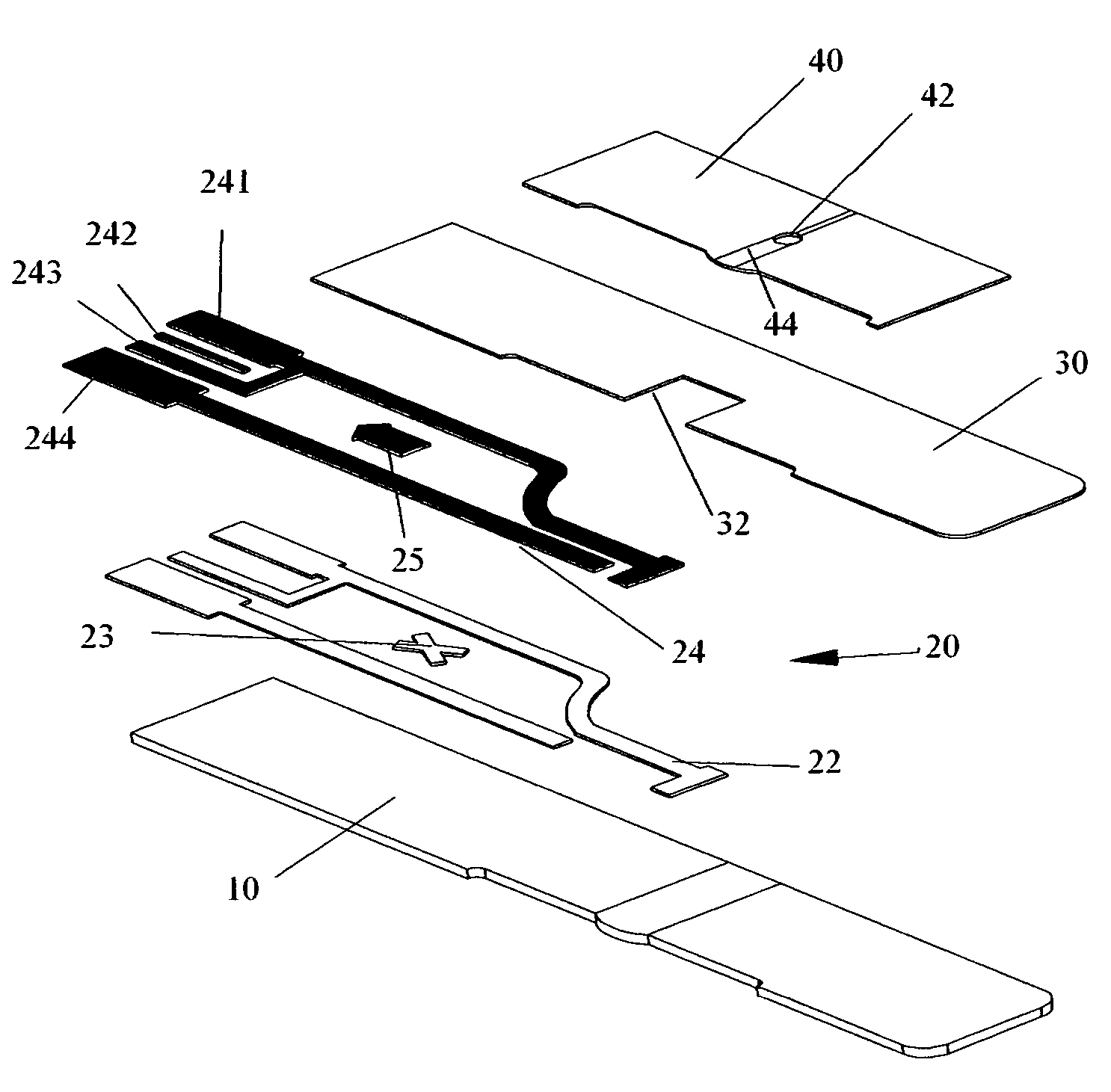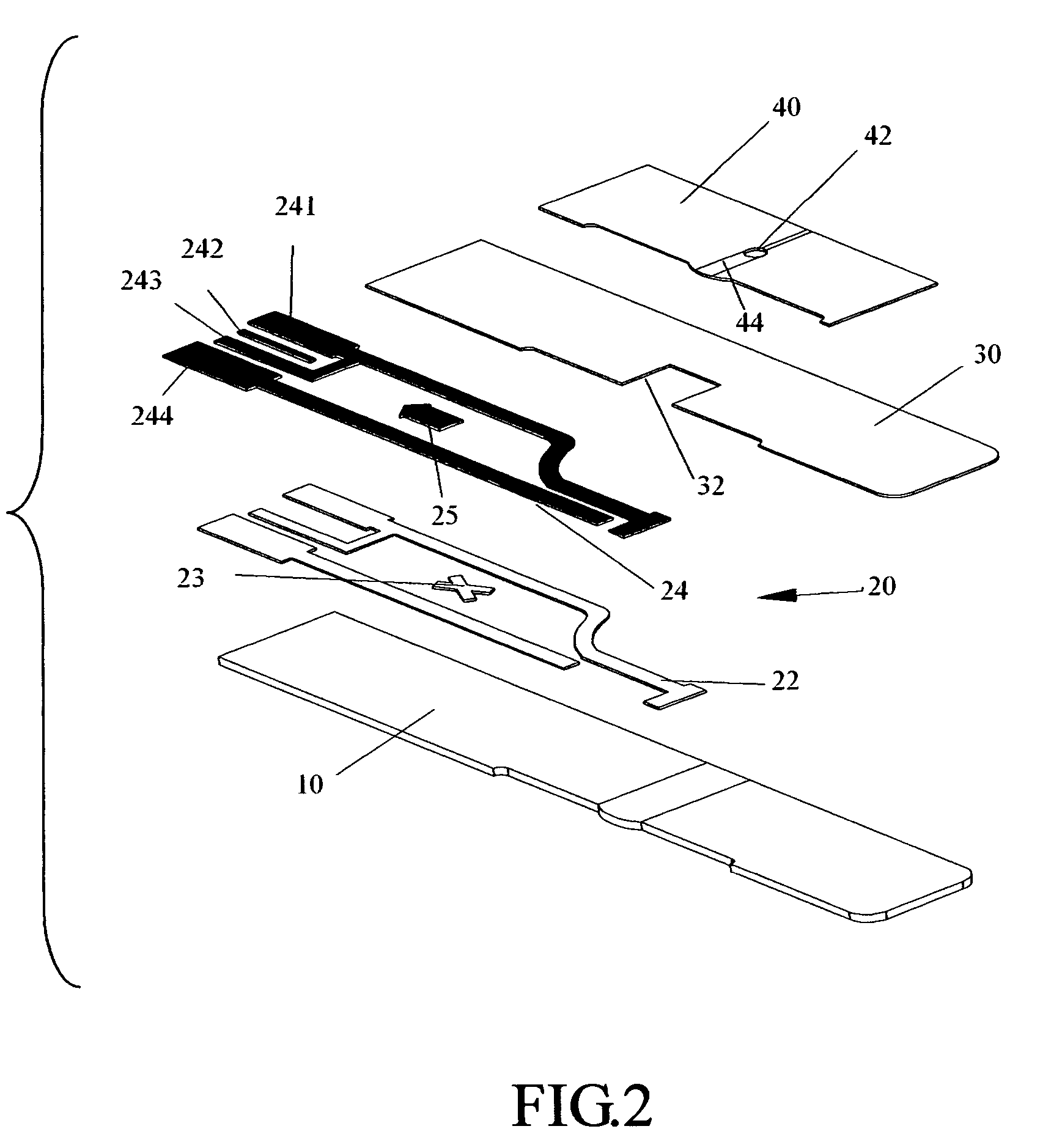Electrochemical biosensor strip
a biosensor and electrode technology, applied in the field of electrochemical biosensor strips, can solve the problems of inconvenient turning on the meter, inability to test, unstable test reagents on the base, etc., and achieve the effect of increasing the flow rate of test samples and increasing the adhesion of test reagents
- Summary
- Abstract
- Description
- Claims
- Application Information
AI Technical Summary
Benefits of technology
Problems solved by technology
Method used
Image
Examples
first embodiment
[0023] With reference to FIGS. 1 and 2, an electrochemical biosensor strip in accordance with the present invention comprises a base (10), an electrode system (20), a spacer (30), a test reagent and a cover (40).
[0024] The base (10) may be rectangular and preferably is an insulating substance. The electrode system (20) is laid on the base (10) and preferably comprises two layers that are a silver layer (22) and a carbon layer (24). The silver layer (22) is laid on the base (10) and the carbon layer (24) is laid on the silver layer (22). The carbon layer (24) and the silver layer (22) respectively comprise at least three electrodes that respectively have a first end and a second end. In the drawings, the silver layer (22) has three electrodes and the carbon layer (24) has four electrodes that respectively named a first electrode (241), a second electrode (242), a third electrode (243) and a fourth electrode (244). There is a short circuit formed between two electrodes of the carbon l...
third embodiment
[0031] With reference to FIGS. 10 and 11, the electrochemical biosensor strip in accordance with the present invention comprises a base (10a), an electrode system (20a), an insulating substance (50), a spacer (30a) and a cover (40a). The spacer (30a) comprises an opening (32a) formed in an end of the spacer (30a). Preferably, the opening (32a) is T shape. The opening (32a) is used for introducing a sample into the strip. The insulating substance (50) is laid on the base (10a) and has an opening (52) formed corresponding to the opening (32a). The test reagent is laid on the opening (52) and the opening (32a). The electrode system (20a) has three electrodes and there is a short circuit between two electrodes of the three electrodes.
fourth embodiment
[0032] With further reference to FIG. 12, the electrochemical biosensor strip in accordance with the present invention further comprises a rough unit (26a) formed on the base (10a). The rough unit (26a) is formed on one end of the base (10a). In the drawing, the rough unit (26a) is parallel with one end of the electrode and near an outside of the base (10a) corresponding to the test reagent. Preferably, the rough unit (26a) is formed adjacent to the electrode.
[0033] In use, because of the users do not need to open the meter it is advantageous to increase useful convenience of using the strip. When users are inserting the strip into the meter, the short circuit structure of the strip will switch on the meter which is designed with the strip. When the strip switched on the meter indicates that the strip is correct to the corresponding meter. This step will increase test accuracy for preventing some parameters in the meter is wrong so that the test result will not correct. It will save...
PUM
| Property | Measurement | Unit |
|---|---|---|
| Adhesion strength | aaaaa | aaaaa |
| Conduction | aaaaa | aaaaa |
Abstract
Description
Claims
Application Information
 Login to View More
Login to View More - R&D
- Intellectual Property
- Life Sciences
- Materials
- Tech Scout
- Unparalleled Data Quality
- Higher Quality Content
- 60% Fewer Hallucinations
Browse by: Latest US Patents, China's latest patents, Technical Efficacy Thesaurus, Application Domain, Technology Topic, Popular Technical Reports.
© 2025 PatSnap. All rights reserved.Legal|Privacy policy|Modern Slavery Act Transparency Statement|Sitemap|About US| Contact US: help@patsnap.com



